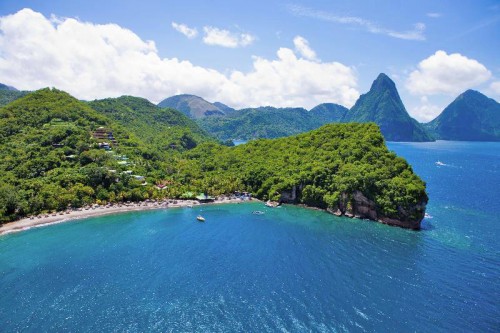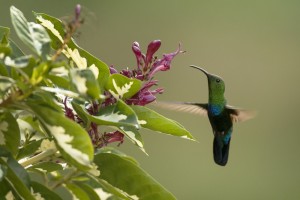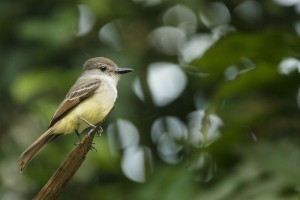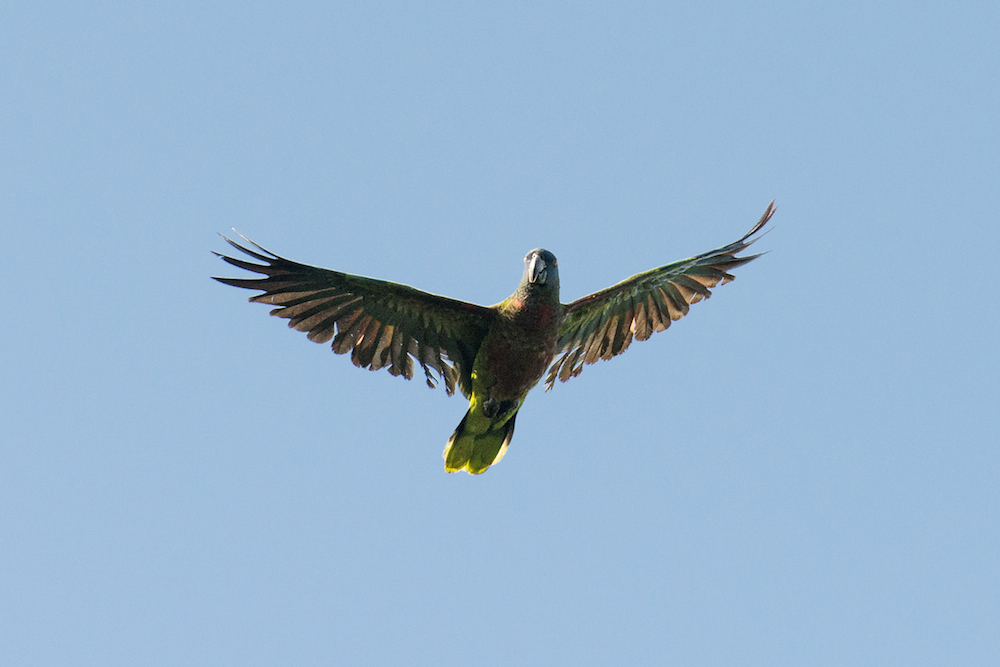Ed Drewitt is a freelance naturalist showing people wildlife around the world. He also studies urban Peregrines and has a book published in June. Ed has been birdwatching in st lucia at Anse Chastanet with his groups for the past 4 years.
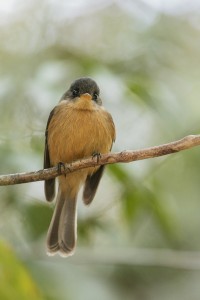
Saint Lucia Pewee, a delightful small flycatcher; green on top and orange underneath which sallies out from its favored perch in search of prey before returning to the same branch.
Once you step off the plane onto the runway in St Lucia the hot sunshine hits your skin; the air smells and feels tropical and moist. The lush vegetation and colourful flowers grace towns and villages on your way to Anse Chastanet. On every other power line Grey Kingbirds, a type of flycatcher, stand tall waiting to fly out in a circle to catch an insect while gangs of Carib Grackles, black, glossy birds related to the Starling look for grubs and insects. Anse Chastanet offers the ideal location to spot common birds of St Lucia including many that are only found on the island (endemics) and is well positioned to travel out from on day trips to see many of the more secretive and rarer birds in the mountain rainforests.
As you enter the Treehouse Restaurant for breakfast it is worth taking your binoculars and camera to spot the local Lesser Antillean Bullfinches, bright yellow Banaquits, and iridescent Carib Grackles looking for titbits. You may even be lucky to spot a Grey Trembler, quivering its wings in excitement. If you take a table looking out across the tree canopies you have a good chance of spotting some shy species such as the Spectacled Thrush, a brown thrush with yellow colour skin around its eyes. From the bar you can enjoy the freshest of cocktails while watching Scaly-breasted Thrashers feeding in the adjacent trees, and as the sun drops below the horizon the beautiful song of the Tropical Mockingbird permeates the airwaves. Free-tailed Bats begin to fly around in big numbers, and down by the beach the White-crowned Night Heron may appear to feed on Ghost Crabs.
Keep your eyes up towards the sky – you never know what may pass overhead from frigatebirds to Brown Boobies, and Peregrines to Ospreys. Throughout Anse Chastanet the colourful, tubular flowers provide the perfect food source for hummingbirds. There are three to look for – the Antillean Crested Hummingbird, green with a distinctive crest on its head; the Purple Carib, often looks black but in the right light to a lovely purple or Merlot red; and the Green Carib, a green hummingbird but without the crest.
In the nearby Anse Mamim Broad-winged Hawks and American Kestrels may soar overhead and the woodland is home to Spectacled Thrushes, vireos, St Lucia Warblers, and St Lucia Peewees.
The stream running through the woods is a good spot to look for Spotted Sandpipers, Blue and Green Herons. The dawn chorus around 6am is a time to listen for the Grey Kingbirds – the main sound you will hear in the morning accompanied by the calls of Zanaida Doves and perhaps the mockingbird. An early start is also a good time to visit some of the forest nature reserves where you have the chance to see the endemic parrot, the St Lucia Parrot. A colourful bird, this large parrot disappears in its forest habitat as its colours make it very well camouflaged. St Lucia Peewees, St Lucia Warblers and hummingbirds are all common. And in these areas you may also see or hear the St Lucia Oriole, a black and yellow bird with steely grey legs and beak and the Rufous-throated Solitaire with its beautiful single note song. Meanwhile, the Millet reserve is a good place to watch for the St Lucia Black Finch as it comes to feed on coconuts put out for it.
Whether you just want to chill on the beach or fancy more of an adventure around Anse Chastanet’s estate or further afield into the native forests you can be sure to see something and catch a glimpse of St Lucia’s wild side when you go birdwatching in st lucia.
About Anse Chastanet: Tranquility, Romance, Adventure: You can still find the Classic Caribbean at Anse Chastanet on St. Lucia’s quiet southwestern coast where two magical peaks, the Pitons, leap from the sea and the mountains are covered with luminous greenery. Architect owner Nick Troubetzkoy believes passionately in nature. So he created a hotel that makes the foliage and the flowers, the perfumes and the peaks, the sea and the bird song an integral part of your vacation experience. The estate encompasses 600 lush tropical acres bordering two soft sand beaches. The resort’s two crystal-clear bays are part of a designated marine reserve protecting colorful coral reefs teeming with tropical fish.
Bird watching at Anse Chastanet: Guests staying at Anse Chastanet Resort Saint Lucia will have many opportunities for bird watching all around the resort’s 600 acre estate, especially in the Anse Mamin plantation. The estate guides are trained bird watching guides. Bird watching activities are offered on the daily/weekly excursion schedule and can be arranged à la carte whilst at Anse Chastanet.
The following bird watching package can be added to any reservation at Anse Chastanet:
Guests who wish to pre-book a bird watching package can book the Anse Chastanet Bird watching Package: The package includes five days of specific excursion activities tailored to provide the best experiences available for bird watching enthusiasts, taking full advantage of the Resort’s location on the southwest coast near the town of Soufriere and the world famous Pitons. As a UNESCO World Heritage Site, the area is a notable attraction to eco-minded tourists from around the world. Excursion activities begin with a visit to the Anse Mamin Plantation, the 400 acre historical estate which is part of the resort property.
Trails within this lush coastal tropical estate with its 18th century plantation ruins are ideal for birding. The bird watching package also includes a visit to the Millet Bird Sanctuary where over 30 bird species can be seen, including five endemic species: the Saint Lucia Parrot, Saint Lucia Black Finch, Saint Lucia Warbler, Saint Lucia Oriole and Saint Lucia Pewee. Participants will also enjoy Saint Lucia’s lush rain forest on the Des Cartier Trail. Following ridge tops at about 1,800+ feet above sea level, this relatively easy 1.5 mile loop hike takes you through one of the wettest tropical forests on earth receiving as much as 150-200 inches of rain annually. The Saint Lucia Parrot is readily encountered along this trail. The package also features a hike to the top of Gros Piton, one of Saint Lucia’s two iconic mountains. A Dolphin & Whale Watching boat tour will let experience sea birds along the way. Also included is a visit to the Diamond Falls & Botanical Gardens and an enjoyable easy hike on the majestic Tet Paul Nature Trail. Anse Chastanet Resort’s 5 day bird watching activities package, all enjoyed on a private basis, can be added to any reservation at Anse Chastanet or Jade Mountain for US 695 per person (minimum 2 persons), plus 10% VAT.
For more information about Anse Chastanet Resort and the resort’s bird watching activities, visit www.ansechastanet.com, email: ansechastanet@ansechastanet.com or call 1-800-223-1108
Wildlife photography courtesy of Sam Hobson, copyright with Sam Hobson and Anse Chastanet Resort.


